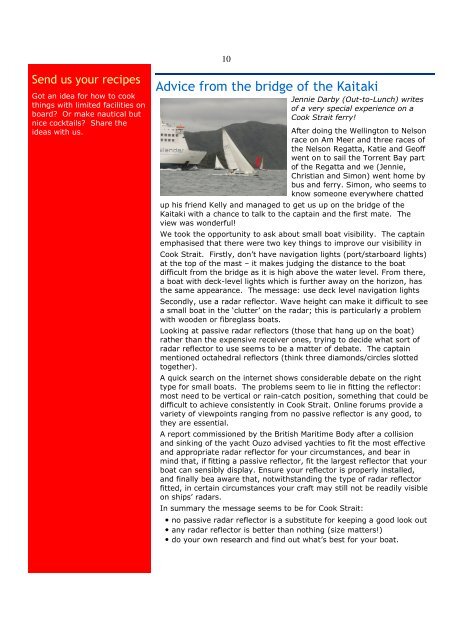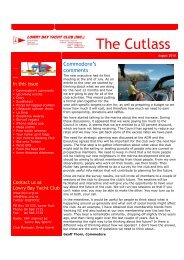Create successful ePaper yourself
Turn your PDF publications into a flip-book with our unique Google optimized e-Paper software.
Send us your recipes<br />
Got an idea for how to cook<br />
things with limited facilities on<br />
board? Or make nautical but<br />
nice cocktails? Share the<br />
ideas with us.<br />
10<br />
Advice from the bridge of the Kaitaki<br />
Jennie Darby (Out-to-Lunch) writes<br />
of a very special experience on a<br />
Cook Strait ferry!<br />
After doing the Wellington to Nelson<br />
race on Am Meer and three races of<br />
the Nelson Regatta, Katie and Geoff<br />
went on to sail the Torrent <strong>Bay</strong> part<br />
of the Regatta and we (Jennie,<br />
Christian and Simon) went home by<br />
bus and ferry. Simon, who seems to<br />
know someone everywhere chatted<br />
up his friend Kelly and managed to get us up on the bridge of the<br />
Kaitaki with a chance to talk to the captain and the first mate. <strong>The</strong><br />
view was wonderful!<br />
We took the opportunity to ask about small boat visibility. <strong>The</strong> captain<br />
emphasised that there were two key things to improve our visibility in<br />
Cook Strait. Firstly, don’t have navigation lights (port/starboard lights)<br />
at the top of the mast – it makes judging the distance to the boat<br />
difficult from the bridge as it is high above the water level. From there,<br />
a boat with deck-level lights which is further away on the horizon, has<br />
the same appearance. <strong>The</strong> message: use deck level navigation lights<br />
Secondly, use a radar reflector. Wave height can make it difficult to see<br />
a small boat in the ‘clutter’ on the radar; this is particularly a problem<br />
with wooden or fibreglass boats.<br />
Looking at passive radar reflectors (those that hang up on the boat)<br />
rather than the expensive receiver ones, trying to decide what sort of<br />
radar reflector to use seems to be a matter of debate. <strong>The</strong> captain<br />
mentioned octahedral reflectors (think three diamonds/circles slotted<br />
together).<br />
A quick search on the internet shows considerable debate on the right<br />
type for small boats. <strong>The</strong> problems seem to lie in fitting the reflector:<br />
most need to be vertical or rain-catch position, something that could be<br />
difficult to achieve consistently in Cook Strait. Online forums provide a<br />
variety of viewpoints ranging from no passive reflector is any good, to<br />
they are essential.<br />
A report commissioned by the British Maritime Body after a collision<br />
and sinking of the yacht Ouzo advised yachties to fit the most effective<br />
and appropriate radar reflector for your circumstances, and bear in<br />
mind that, if fitting a passive reflector, fit the largest reflector that your<br />
boat can sensibly display. Ensure your reflector is properly installed,<br />
and finally bea aware that, notwithstanding the type of radar reflector<br />
fitted, in certain circumstances your craft may still not be readily visible<br />
on ships’ radars.<br />
In summary the message seems to be for Cook Strait:<br />
• no passive radar reflector is a substitute for keeping a good look out<br />
• any radar reflector is better than nothing (size matters!)<br />
• do your own research and find out what’s best for your boat.





